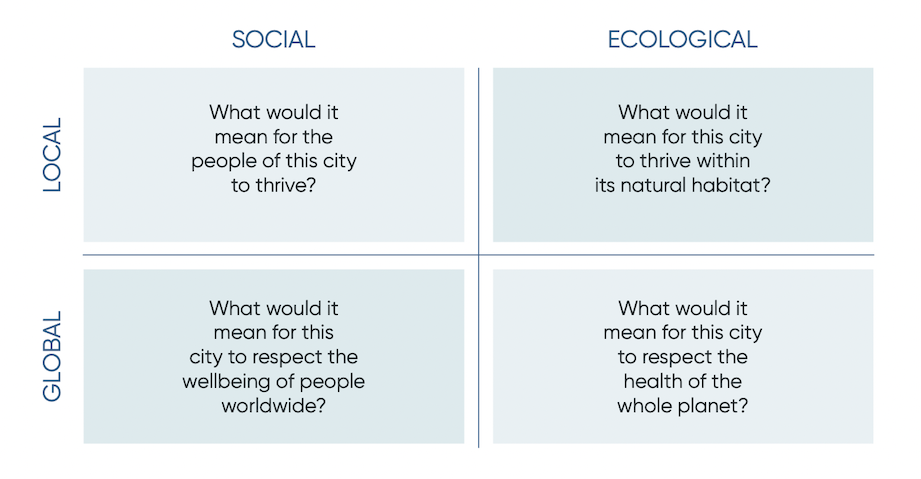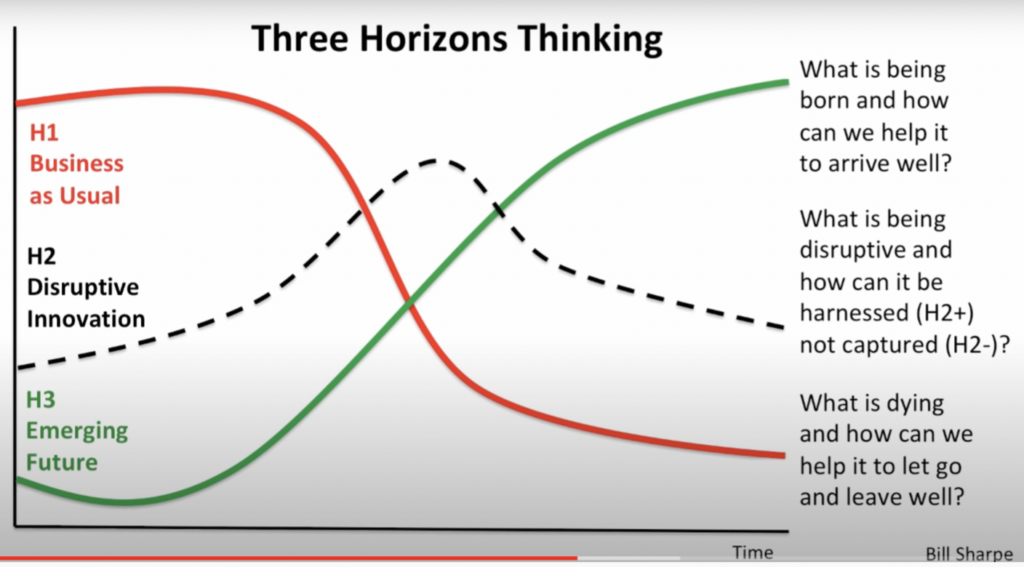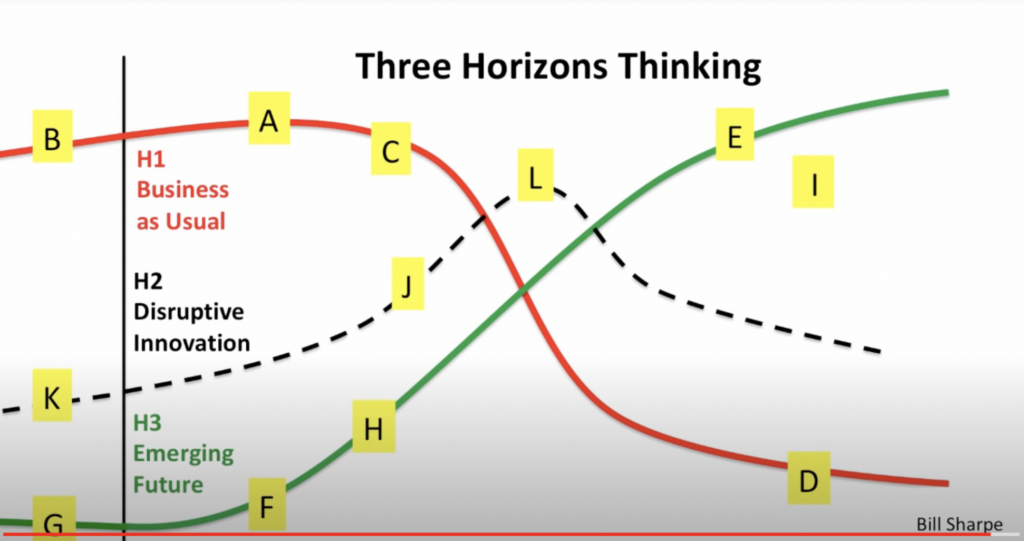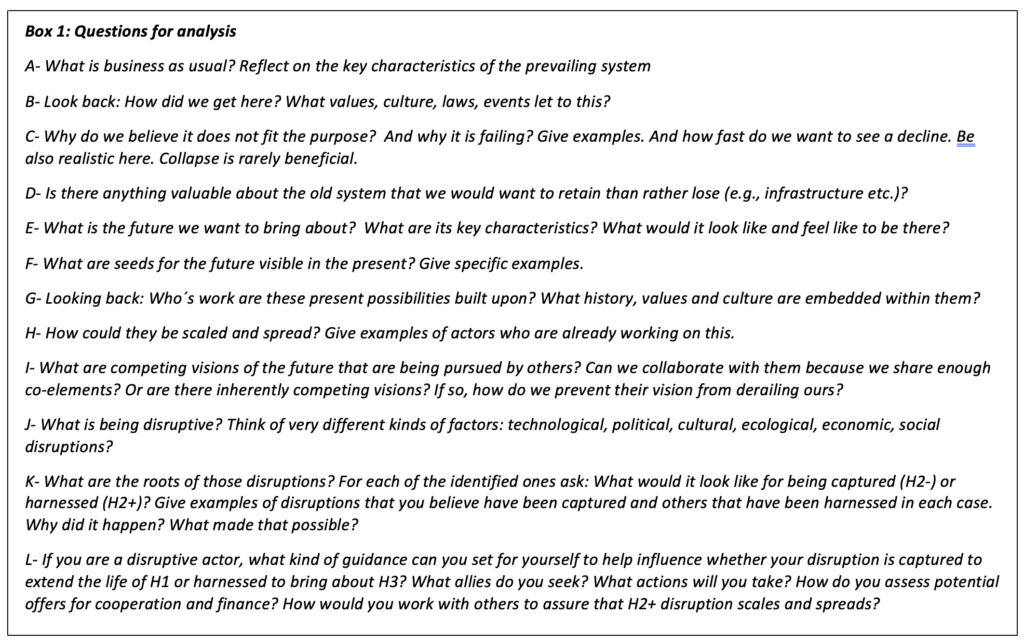„Sustainable Future Cities, Towns and Communities“ (IV)
We introduced the essential aspects of Kate Raworth’s Doughnut in our last blog. But how can we put this approach into practice? How can we successfully transform regions and other locations into doughnut economies? How do we motivate people, organisations and political actors in cities and communities to embark on new search processes and develop new perspectives? How can practice be fertilised with new concrete measures that also allow new experiments?
The doughnut approach has already been used as a strategy tool in many cities. This is where the Doughnut Economics Action Lab (DEAL) and the Thriving Cities Initiative (TCI), launched in 2020, have made a major contribution. The TCI is a collaboration between C40 Cities, the Doughnut Economics Action Lab and the Circle Economy, which strive to create more equitable, sustainable and resilient places for people to live. The network was founded by Raworth and practitioners as an exchange platform to jointly develop tools for the initiation and launching of concrete implementation experiences at local level.
Presentation of two tools for deeper reflection
Here we present two tools that are exemplars for other instruments which help to generate new questions and answers for the design of a sustainable development strategy in cities and locations. They promote new ways of thinking beyond the traditional horizon and offer the possibility of being applied directly in interviews and workshops. We briefly describe the two tools here. They are: a) the City Portrait and b) the Three Horizons Model.
The („Doughnut“) City-Portrait
The „City-Portrait“ reflects with local actors on four questions structured in a 4-field matrix (see diagram below). The aim is to elaborate concrete measures to improve the quality of life and the ecological balance in the locality as well as internationally.

The City Portrait asks what active contribution people, companies, organisations and politics in the city can make and what their real responsibility is to improve the wellbeing of people locally as well as globally and to respect the planetary limits of growth. This perspective of humanity and the planet appeals to local responsibility for global conditions and focuses on the implementation of corresponding local measures. This raises new issues and questions, such as:
- To what extent do local economic sectors, businesses and production methods, as well as their supplier relationships, contribute to healthy global development?
- How does our own energy and resource consumption relate to poorer people and countries?
- What are dominant local consumption patterns and their global social and environmental impacts globally?
Implementation example Amsterdam and different success indicators
The DEAL and the TCI have already elaborated this „City Portrait“ in the context of urban The DEAL and the TCI have already elaborated this City Portrait in the context of urban development processes in many places. Cities such as Amsterdam have developed interventions and associated projects along the four fields in a participatory process. In contrast to traditional success indicators such as growth, jobs and competitiveness, other success criteria are measured here: health, inclusion, liveable income, community wellbeing, mobility, participation and co-creation , among others, which are at the centre as essential development factors. An example of the multitude of results can be found here for the city of Amsterdam.
The City Portrait and its strategy approach ultimately aims to have places and city regions align their development process between the two doughnut rings, the space Kate Raworth calls the „safe and just place for humanity“ (see last blog). The tool is also suitable for small awareness-raising workshops and project design.
The „Three Horizons Model
A second tool we present here is the 3 Horizons Model by the researcher Bill Sharpe. It is designed to support the transformation towards innovative and more sustainable A second tool we present here is the Three Horizons Model by the researcher Bill Sharpe. It is designed to support the transformation towards innovative and more sustainable development paths (see diagram below). The aim is to identify and overcome innovation solutions with a negative setting and social impact („Business as Usual“ horizon 1, H1) and to strengthen new innovative paths that contribute to more sustainable development („Viable Future“ horizon 3, H3). An important bridging role here is played by the orientation and promotion of future innovation development (Horizon 2, H2). These innovations can either prolong the „business as usual“ process of companies and societies (H2-) or contribute to the necessary and more sustainable future path(H2+).

„How can an innovative and green transformation process be analysed and supported in a local business sector or community?“. this could be a question for a workshop with selected stakeholders.
Kate Raworth presents a possible workshop approach using Bill Sharpe’s model in an internet video. She identifies three essential questions for a change process that can also be used in a workshop:
1) What is being born and how can we help it to arrive well? (H3)
2) What is dying and how can help we it to let go and leave well? (H1)
3) What is being disruptive and how can it be harnessed (H2+), not captured (H2-)?
Kate Raworth provides another list of questions in her video explanation that are helpful for a deeper and more detailed approach to analysis. (see diagram below). The short and long list of questions can be used very well for workshops and can be applied to economic sectors as well as to social development trends.


Experiment with the instruments and share your experiences!
In our view, both tools presented here bring new perspectives to the reflection on social and economic development. They can also initiate new solution paths and experiments. Try them out and tell us about your experiences.
Authors: Frank Waeltring and Guido Zakrzewski
Additional information and links
The „City Portrait“
The Thriving City Initiative (TCI)
A video by Kate Raworth where she describes the city portrait and its application.
The City Portrait Canvas Guide with materials, templates and video description for using it in workshops
Creating City Portraits, A methodological guide from The Thriving Cities Initiative (TCI), Case Amsterdam
Blog post by Duncan Green on the TCI initiative and the DEAL
More workshop information and real practice examples can be find at the Practice Centre web page.
The Three Horizons model
Three Horizons, The Patterning of Hope, by Bill Sharpe (as the developer of the tool and approach) – E–book link
A video introduction to the Three Horizons by Kate Raworth:
A video with Bill Sharpe where he explains the approach and the status himself.
A website that explains the Three Horizons model easily and nicely visualized
Transformative Innovation, A Guide to Practice and Policy, by Graham Leicester (the first chapter can be read here for free) A very good publication and description of the approach´s transformational character of the approach
For use of the instrument in workshops and real practice visit the Practice Centre web page which provides more information on the tool and on transformative innovation.
Other Blogs of the series
